14+ Sample Hazard Assessment Checklist
-
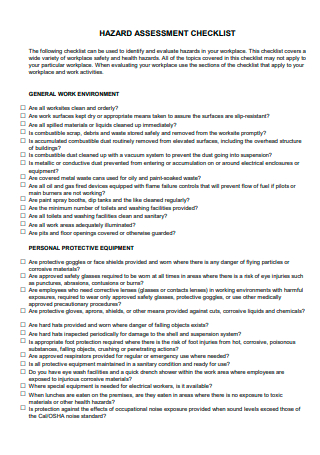
Hazard Assessment Checklist Template
download now -
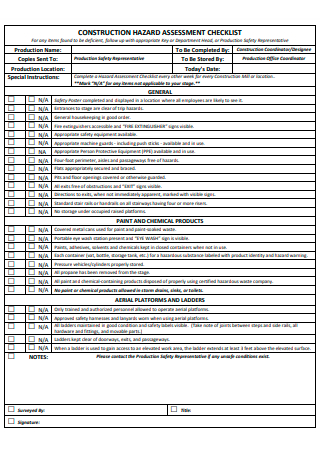
Construction Hazard Assessment Checklist
download now -

Production Hazard Assessment Checklist
download now -
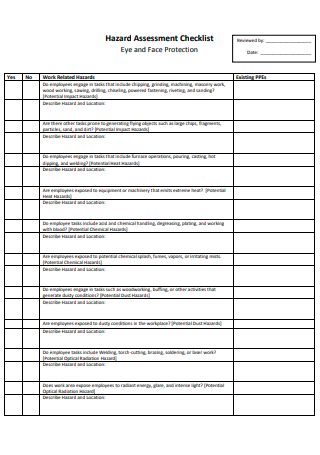
Hazard Assessment Checklist Example
download now -
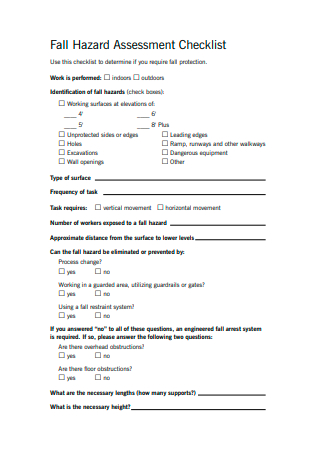
Hazard Assessment Checklist in PDF
download now -
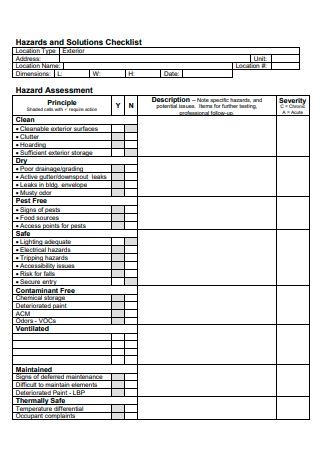
Hazard Assessment and Solutions Checklist
download now -
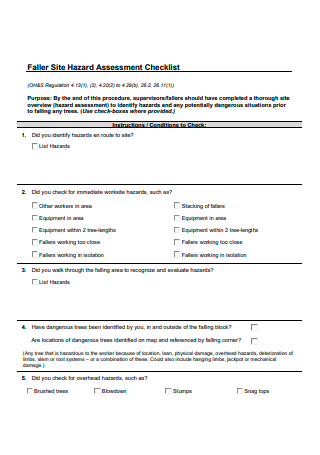
Site Hazard Assessment Checklist
download now -
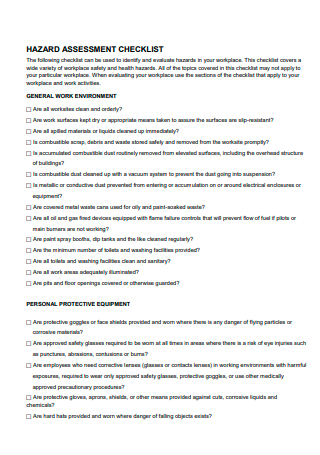
Formal Hazard Assessment Checklist
download now -
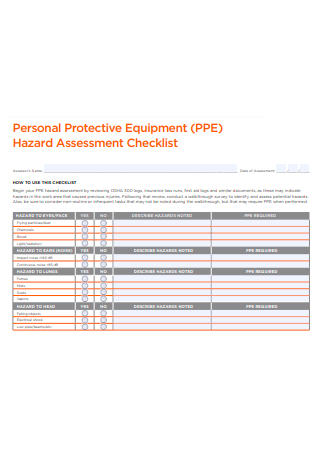
Printable Hazard Assessment Checklist
download now -
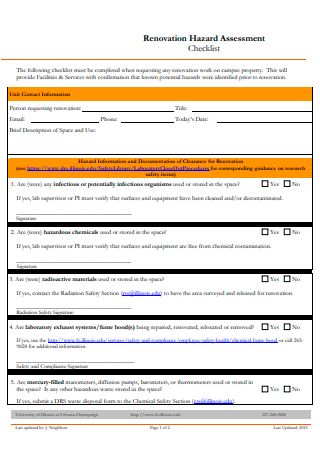
Renovation Hazard Assessment Checklist
download now -
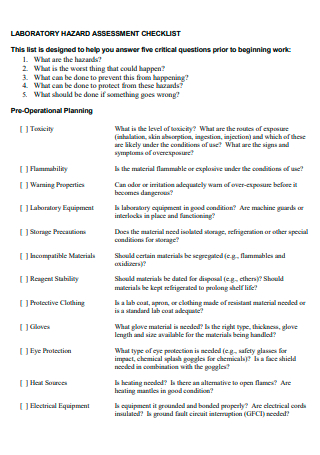
Laboratory Hazard Assessment Checklist
download now -
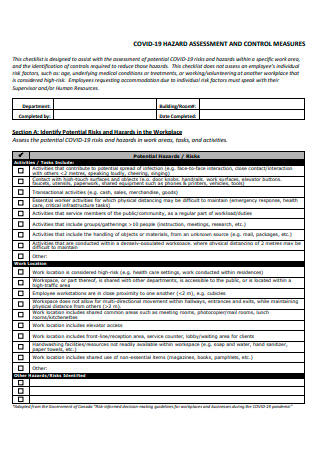
Covid-19 Hazard Assessment Checklist
download now -
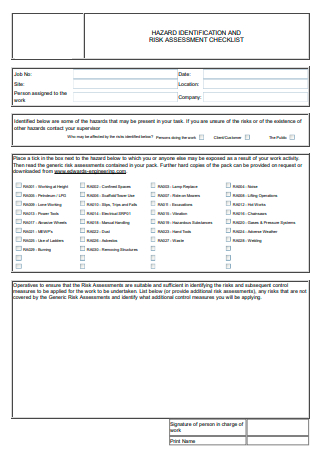
Hazard Identification and Risk Assessment Checklist
download now -
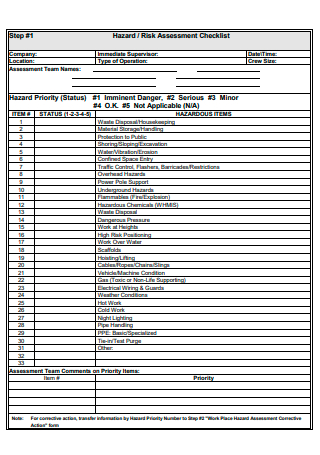
Hazard Risk Assessment Checklist
download now -
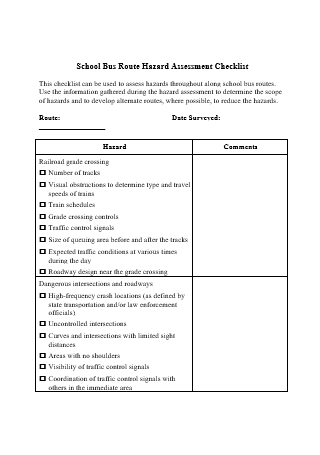
School Bus Route Hazard Assessment Checklist
download now
FREE Hazard Assessment Checklist s to Download
14+ Sample Hazard Assessment Checklist
What is a hazard assessment checklist?
Different Kinds of Hazards
How to Perform Hazard Assessments
Is a hazard assessment required?
How often should a hazard assessment be conducted?
Do I need a hazard assessment checklist to perform a hazard assessment?
What is a hazard assessment checklist?
When safety officers conduct hazard assessments, it is important for them to have a tool that will help them have definite targets to focus on during the entire process. Health and safety hazards are identified in the workplace through this by looking into the various conditions and settings within the area. Potential health and safety hazards are better distinguished using this tool, and enables the safety officer to better check the workplace. It makes it easier for them to conduct the examination, and even makes the whole process factor since this checklist essentially serves as a guide. With this, companies or corporations are better able to have safety measures and provide solutions for existing problems in the workplace. It is also important to have hazard assessments regularly in order to keep records up to date, letting you keep up with the dynamic nature of workplaces in and of themselves.
Different Kinds of Hazards
Hazards may very popularly be confused with risks, however, it is important to be able to distinguish the two especially when you are conducting a hazard assessment. To differentiate the two, hazards are a source that carries the potential harm in and of itself, that may highly result to human injury, repercussions to one’s health, property destruction, harms to the environment, or all of those at once. Risks, on the other hand, refer to the probability of those mentioned happening. An example of which is fire risk, since it talks about the likelihood of fire happening in a certain workplace, for instance. Nonetheless, when conducting hazard assessment, you should be able to identify the different kinds of hazards for you to examine respective areas better and more holistically. These are the different kinds of hazards.
How to Perform Hazard Assessments
Job safety analysis is an important task for companies or businesses to conduct for the well-being of employees. Hazards are things that heavily affect employees, and may cause them to have less productivity, ultimately harming themselves, as well as the the company in and of itself. A job safety analysis is a procedure that makes sure that working standards are met by the company, and that their employees are safeguarded from different harms that could affect them while working. What constitutes this is a hazard assessment that helps in identifying these harms in and of themselves. A hazard assessment checklist makes the task easier for the officer conducting the assessment, since it provides a breakdown of the important aspects to look into in order to make a holistic record that could guide the employers into creating a safer space for workers. This is how you can perform hazard assessments.
Step 1: Hazard identification
Hazard identification may be easily done with the use of your hazard assessment checklist since it elaborates on the important things that you should be looking into in order to craft a bullet-pointed list of individual hazards. These hazards may very well come in the form of those mentioned above such as the ergonomic hazards, biological hazards, physical hazards, chemical hazards, and psychosocial hazards. The identification of these is the primary step in assessing job safety, since they are the independent variables to the actions that the company or business may need to commit to in order to solve or mitigate them. It is important for the officer to make the hazards as explicit as possible in order for solutions to directly target them, and to be tailor-fit to fix them for the employees.
Step 2: Exposure assessment
Exposure assessment pertains to the likelihood or frequency of employees being exposed to the hazards identified in the first step. It is important to conduct this step because it provides a clearer picture of the severity of how these hazards may affect the workers. This means that the coverage of the material causing the hazard is then gauged by the officer. This is how they may be able to trace the origins of the hazard, and even preempt the likelihood of other sub-hazards emerging in the workplace. Moreover, the magnitude or severity of the hazard is also looked into during this step. Basically, exposure assessment is done in order to measure how much the employee is affected by the hazard, and to assess the hazard, its origins, and its effects to the employee in and of itself.
Step 3: Response assessment
After conducting the exposure assessment, it is important for the officer then to conduct a response assessment. Response assessment is essentially the checking and balancing of formulated responses towards the identified hazards. It is ultimately why a hazard assessment was made in the first place. During this step, the officer determines the appropriate responses and safety measures that directly counter the mentioned hazards. Mitigating factors, rationing of schedules, restructuring a workplace, and the like could be possible responses to specific hazards. Nonetheless, these viable options are gauged in terms of effectiveness in this step, as they are made to promise to cater to the need to eliminate hazards to begin with. This step is how employers are able to minimize the risks that these hazards ultimately pose towards their constituents.
Step 4: Risk characterization
Risk characterization is the final step of the assessment of hazards in the workplace. It is essentially the analysis of the potential risks that respective hazards may result to. Characterizing these risks offer a clearer sight of the things that may happen if hazards are not responded to, or if safety measures fail to do their job. This step enables companies or businesses to have contingency plans in order to counter the risks. Being the final step of the assessment, this basically solidifies the formulating of records regarding possible hazards in the workplace.
Is a hazard assessment required?
The Occupation Safety and Health Administration requires a hazard assessment to be conducted in the workplace. They are a regulatory agency that aims to safeguard workers in their respect areas of work. Ultimately, hazard assessments must be done since it is a way employers, or business and company owners protect their employees’ well-being, and ensure that they are working within humane and acceptable working conditions. This procedure is required by law.
How often should a hazard assessment be conducted?
Hazard assessments are to be done at least once a year. It is very possible that hazards may also change due to the dynamic nature of work in and of itself. This means that a company’s records of hazards should be kept up-to-date in order to make sure that the needs of the employees are ultimately catered to by those who own the company. It also keeps the mitigating actions or responses to be updated, meaning that the likelihood of the negative impacts accruing is very less.
Do I need a hazard assessment checklist to perform a hazard assessment?
It is highly advisable for you to do so, because hazard assessment checklists contain the bulk of the concerns that you should be looking into. It provides an explicit number of points that need to be catered to, since they are usually crafted by virtue of precedence, meaning that the things listed in these checklists are the things that have had a lot of recorded incidents, for instance. Generally speaking, the hazard assessment checklist makes the job easier for you since it has different types of factors laid down for you to assess. Should there be any additional factors, it is then a lot faster for you to just make addenda.
Caring for employees is the bare minimum for companies to make in order to preemptively pay workers back for the things that they do. Hazard assessment is needed in order for them to be provided with the proper aid, equipment, and stations in order to do their work safely and well. This is also used as precedence to determine what kind of protective personal wear they need to use, and the structuring of the workplace managed by those who own it. Making sure that employees are safe truly is a zero sum game, since it benefits the workers by securing their health and safety, all the while benefiting the company as well by ensuring a high rate of productivity because of the mitigated likelihood of health concerns that hold employees back.
